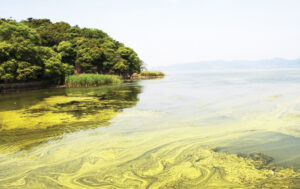 Washington, D.C., October 22, 2022: Today, Representative Marcy Kaptur (OH-09) – Chair of the House Appropriations Subcommittee on Energy and Water Development – announced the National Oceanic and Atmospheric Administration has awarded nearly $1.5 million in federal funding to projects focused on combatting harmful algal blooms in the Great Lakes.
Washington, D.C., October 22, 2022: Today, Representative Marcy Kaptur (OH-09) – Chair of the House Appropriations Subcommittee on Energy and Water Development – announced the National Oceanic and Atmospheric Administration has awarded nearly $1.5 million in federal funding to projects focused on combatting harmful algal blooms in the Great Lakes.
The National Oceanic and Atmospheric Administration (NOAA) has awarded a total of $1,478,701 to five projects focused on combatting harmful algal blooms in the Great Lakes. The funding will support a variety of research and technological projects being led by regional and national partners – including the University of Toledo and Bowling Green State University – in both the public and private sectors.
“Lake Erie and the entire Great Lakes system are inseparable from every facet of our region’s way of life,” said Rep. Kaptur. “From drinking water and agriculture to our multibillion-dollar boating, fishing, and tourism industries – protecting the Lakes protects us all. These federal investments will continue the vital work necessary to tackle the scourge of harmful algal blooms and preserve our precious freshwater bounty.”
NOAA project funding
- $281,975to improve understanding of the synergistic impacts of acidification, temperature, total alkalinity, and nutrients on toxic cyanobacteria harmful algal blooms in the Great Lakes – University of Toledo, University of Michigan, Oberlin College, University of Minnesota Duluth, University of Kentucky
- $75,092to create portable cyanotoxin detection technology for use by citizen scientists and decision makers – University of Toledo, Bowling Green State University, Ohio State University, University of Michigan Cooperative Institute for Great Lakes Research, MBio Diagnostics, Inc., LimnoTech, Inc.
- $296,205to enhance existing technology for rapid, portable, multiplexed detection of harmful algal toxins in the Great Lakes – Bowling Green State University, State University of New York, MBio Diagnostics
- $370,000to upgrade existing instrumentation in the Great Lakes to improve telemetry and harmful algal bloom data integration – Great Lakes Observing System
- $455,429to enhance the capabilities of the 3rd generation Environmental Sample Processor for harmful algal bloom toxin detection through integration with an Autonomous Surface Vehicle – University of Michigan Cooperative Institute for Great Lakes Research, Louisiana State University, Monterey Bay Aquarium Research Institute
More information on the NOAA project funding can be found at www.noaa.gov.

